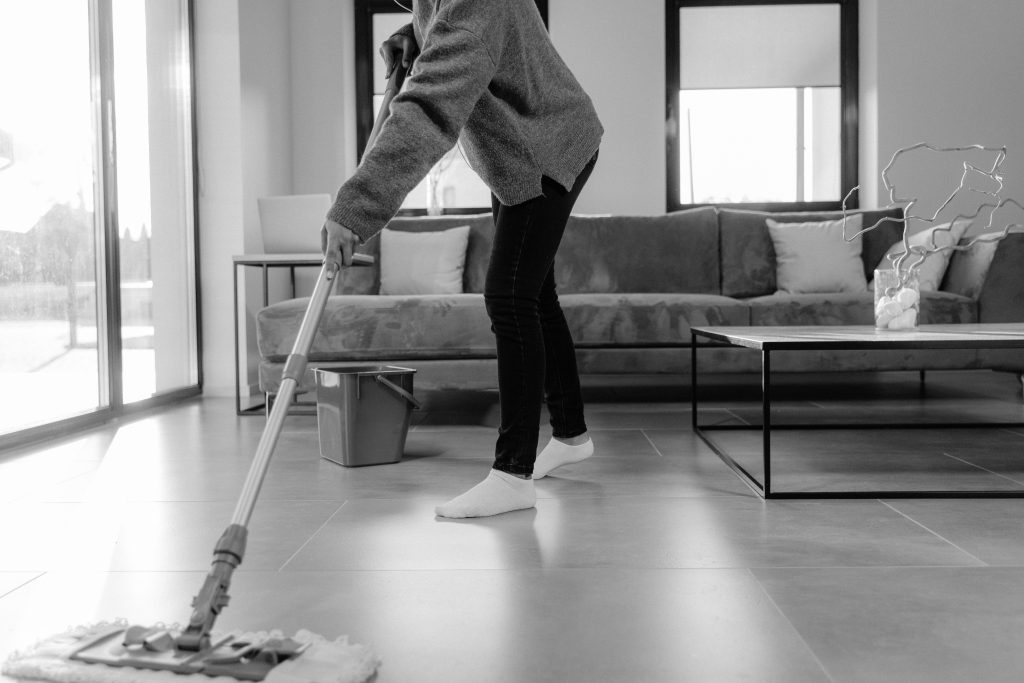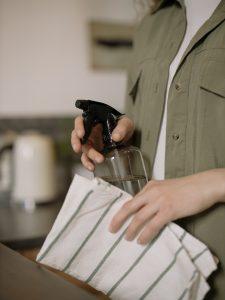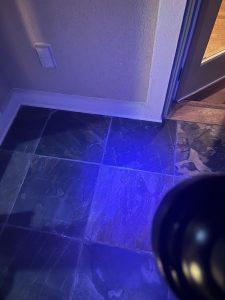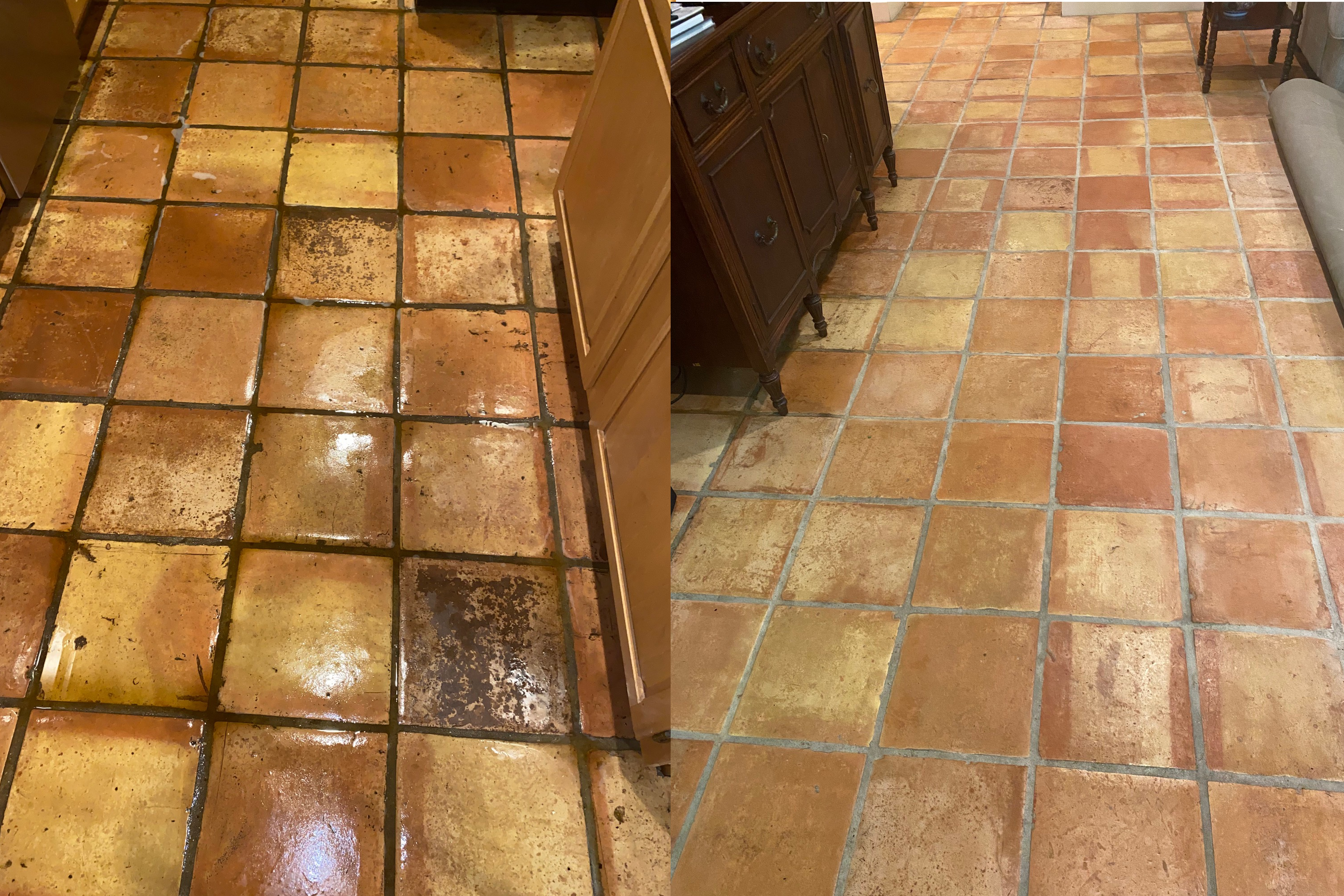Tile floors are a popular flooring choice for many homeowners. They can be found in kitchens, bathrooms, and other areas of the home. While tile floors are known for their durability, they still need to be cleaned regularly to keep them looking their best. This article will discuss how to clean tile floors properly so that they remain beautiful and free of dirt and grime.
Tile floors require special care when it comes to cleaning. Different types of tiles may need different cleaning techniques or products in order to get them really clean without causing any damage. Knowing which products to use on your specific type of tile as well as the proper steps for cleaning is essential.
Below, we’ll discuss the basics of cleaning tile floors, including what types of cleaners work best and which methods should be avoided. Additionally, tips and advice on maintaining your tile floor properly so that you can keep it looking great long-term.
Supplies Needed For The Job
Cleaning tile floors requires the right supplies to ensure effective and safe cleaning. To begin, a vacuum cleaner or broom is necessary to remove dirt, dust, and debris from the surface of the tiles. A mop can then be used to clean the floor with a mild detergent solution. The solution should be one that is not too harsh for the tile material; pH neutral solutions are best for this purpose as they do not cause damage.
Additionally, it may be beneficial to use a grout brush in order to remove any dirt or buildup present in between tiles. Finally, if needed a special tile sealant can be applied in order to protect the tiles from staining or further buildup.

Preparing The Room For Cleaning
Before beginning to clean tile floors, it is important to prepare the room. This includes removing all objects from the floor that could get in the way of cleaning, such as furniture and throw rugs. It is also useful to secure any vents and doors to prevent dirt from getting into other areas of the house. In addition, it is essential to make sure that the area being cleaned has been vacuumed or swept beforehand. This will help ensure that no dust or debris accumulates on the tile during the cleaning process.
Next, a cleaning solution should be prepared according to manufacturer’s instructions. When using a chemical cleaner, it is important to wear protective gloves and safety glasses when handling and diluting chemicals. Additionally, ventilation should be provided while working with these products. Once mixed with water as directed, a mop or cloth can be used with the solution for cleaning tile floors.
When mopping tile floors with a chemical cleaner, it is important to move in one direction with overlapping strokes and not scrub too hard on grout lines as this can loosen them over time. After ensuring all areas are covered, the floor should be allowed ample time to dry before walking on or replacing furniture in order to prevent slipping or staining from moisture left behind on tiles.
Vacuuming The Floor
Vacuuming the floor is an important step in cleaning tile floors. Vacuuming removes dirt and dust particles that can cause scratches in the finish of the tile. It also helps to remove any loose debris that may have accumulated on the surface of the tile. To properly vacuum a tiled floor:
- Set the vacuum cleaner to its lowest setting; this will prevent any damage to the tiles’ finish.
- Move slowly, using overlapping strokes when vacuuming; this allows for better coverage of the entire area.
- Move furniture out of the way before vacuuming in order to reach every section of the floor more easily.
- Empty and clean out any debris from vacuum after each use to prevent clogging and wear on brushes and other parts of the vacuum cleaner.
These simple steps will help ensure that your tile floors are thoroughly cleaned without causing damage or unnecessary wear on your vacuum cleaner or its components.
Spot Cleaning Stains And Spills
 Having vacuumed the floor, spot cleaning is the next step in cleaning tile floors. Spot cleaning helps remove any specific stains or spills that may have been left behind. To do this, the necessary supplies should be gathered prior to beginning. A solution of warm water and mild dish soap can be used for general spots and dirt areas. For tougher substances such as oil, paint, ink, or chewing gum, a commercial cleaner should be used based on its instructions.
Having vacuumed the floor, spot cleaning is the next step in cleaning tile floors. Spot cleaning helps remove any specific stains or spills that may have been left behind. To do this, the necessary supplies should be gathered prior to beginning. A solution of warm water and mild dish soap can be used for general spots and dirt areas. For tougher substances such as oil, paint, ink, or chewing gum, a commercial cleaner should be used based on its instructions.
It is also important to use a soft-bristled brush when scrubbing the floor tiles with a cleaning solution. Using a brush will ensure that any tough substances are removed from the surface of the tile without damaging it. Additionally, using an old toothbrush can help get into crevices between the tiles.
After scrubbing has been completed, the area should be wiped down with a damp cloth to remove all remaining residue from the tile surface and then dried thoroughly with a dry cloth or paper towel. This will help restore luster to the floor and prevent any build up of dirt and grime in the future.
Deep-Cleaning Solutions For Tough Stains
A deep clean is sometimes necessary to remove tough stains from tile floors. A variety of products are available to assist with this process. For example, an oxygen bleach solution can be used to effectively clean grease, oil and soap scum from the tiles.
To make the solution, mix one-half cup of oxygen bleach powder with a gallon of warm water. Apply the mixture liberally and allow it to sit for 15 minutes before scrubbing it into the floor with a nylon brush. After rinsing with clear water, the floor should be left looking clean and shiny.
Another option for removing difficult stains is using an alkaline cleaner such as ammonia or trisodium phosphate. This type of cleaner is ideal for removing stubborn dirt or scuff marks that have built up over time on the tiles. Mix one tablespoon of cleaner in a gallon of warm water and apply it to the affected areas, then scrub vigorously until all residue has been removed. Rinse thoroughly with clear water afterwards to complete the cleaning process.
The best way to ensure that tile floors remain clean is by practicing proper maintenance techniques such as sweeping regularly and mopping up spills quickly. Doing so will help reduce the need for deep cleans later on.
Use Of Detergents And Other Cleaners
The use of detergents and other cleaners is a common method of cleaning tile floors. Detergents are typically used with hot water to remove dirt, grease, and grime from the surface. Detergent should be applied in a circular motion, avoiding direct contact with the grout or any other porous material that may be present on the tile floor. A mop or cloth can then be used to wipe away residue left behind.
Chemical cleaners such as bleach may also be used for tougher stains and dirt buildup. It should be noted, however, that bleach is not suitable for use on all types of tiles; it should only be used on ceramic or porcelain tiles that are specifically designed to withstand its chemical properties. Additionally, it is important to dilute bleach with water before using it on a tile floor in order to avoid damaging the surface.
Other specialty cleaners may also be employed depending upon the type of tile floor being cleaned. For example, natural stone tiles such as marble and granite require specialized pH-neutral cleaning solutions in order to protect and prevent damage from occurring over time. These types of cleaners can often be found at local home improvement stores and come with specific instructions for application and usage.
Removing Grout Stains
Removing grout stains from tile floors requires some special care and attention. The first step is to determine the type of stain and the source of it. Stains can be caused by many factors, such as dirt, oil, grease, soap scum, mold and mildew, or even paint. It is important to identify the type of stain before attempting to remove it.
The following steps should be taken when attempting to remove grout stains:
- Clean the area with a mixture of one-part white vinegar and one-part water to remove any debris that may have built up around the stain.
- Use a bristled brush or toothbrush to scrub the area around the stained grout. Be sure to use a gentle hand as too much pressure can damage both the tile and grout.
- Apply a cleaning product specifically designed for tile floors onto the affected area and allow it to sit for 10 minutes before scrubbing with a brush or rag. Rinse thoroughly with clean water after scrubbing.
- For tougher stains, try using a poultice paste made from baking soda mixed with hydrogen peroxide or rubbing alcohol mixed with dish soap. Allow this mixture to sit on top of the stained area for at least an hour before wiping away any residue left behind.
Regularly mopping your tiled floors will help prevent future build-up and staining in between deep cleanings. Always use a microfiber mop when cleaning tile floors as this will help reduce water usage and prevent spreading dirt around on the tiles instead of removing it entirely. Microfiber mops are also more absorbent than traditional cotton mops, which can reduce drying times significantly after cleaning has been completed.
Rinsing The Floor After Cleaning
Having completed the initial cleaning of tile floors, it is important to rinse the floor thoroughly. The following steps will ensure that the tiles remain clean and free of residue:
- Fill a bucket with warm water and add a few drops of liquid dish detergent.
- Dip a mop into the solution and wring out excess water.
- Mop the tile floor in a circular motion, taking care to cover all areas.
- Rinse the mop frequently in clean water to avoid spreading dirt around the room.
After completing this process, allow the floor to air dry or use a microfiber cloth to wipe away any remaining moisture. It is also recommended that a second pass be made using just warm water if there is any evidence of soap residue on the tiles after drying. Doing this will ensure that all soap residue has been removed and prevent any discoloration or permanent damage to the tile surfaces due to chemical build up over time. Additionally, this step should be repeated periodically as part of regular maintenance for hygienic purposes and aesthetic appeal in both residential and commercial settings alike.
Drying The Floor
Once the tile floor has been washed, it should be dried with a clean towel. This can be done by blotting the tiles and gently rubbing them. Care should be taken to avoid scrubbing too hard as this may cause scratches on the surface of the tile. It is also important to ensure that all excess water is absorbed in order to prevent any streaking or staining.
The use of a mop can help to speed up the drying process. After washing with a mop, it is important to squeeze out all the excess water before going over the tiles with a dry mop or towel. This will help reduce streaks or spots that may occur due to air-drying alone.
A fan or dehumidifier can also be used after cleaning and drying to make sure that all moisture is eliminated from the room quickly and effectively. By following these steps, users can ensure their tile floors remain clean and spotless for longer periods of time.
Prevention Of Damage To Tiles
Preventive measures can help protect tile floors and reduce the need for cleaning. Proper maintenance of the grout between tiles is one way to prevent damage. Grout should be sealed with a sealant that is compatible with the type of tile used, as well as regularly cleaned with a pH-neutral cleaner and soft brush.
The use of appropriate cleaning materials and tools is also essential for protecting tile floors. Non-abrasive cleaners, such as baking soda or vinegar mixed with warm water, are recommended for regular cleaning. For tougher stains, an oxygen bleach solution may be necessary. A soft-bristled brush or mop should be used when scrubbing the tile surface, rather than a hard bristled brush or steel wool which could scratch it.
Finally, it is important to avoid excessive moisture on tile floors, which could cause damage if left unchecked. Floors should be wiped down after mopping in order to remove any remaining moisture and avoid warping. Rugs or mats placed strategically at entrances can help minimize exposure to dirt and moisture from outside sources.
Techniques For Keeping Tiles Smelling Fresh
 In order to keep tiles smelling fresh, one must take the necessary steps to prevent dirt, dust, and other debris from accumulating. A regular cleaning routine can help prevent odor buildup by removing accumulated grime and bacteria.
In order to keep tiles smelling fresh, one must take the necessary steps to prevent dirt, dust, and other debris from accumulating. A regular cleaning routine can help prevent odor buildup by removing accumulated grime and bacteria.
For more stubborn odors, a solution of white vinegar and water can be used to deodorize the flooring. The solution should be applied directly onto the area being treated and allowed to sit for several minutes before wiping off with a damp rag or mop. Other natural solutions such as baking soda or borax powder may also be used in place of white vinegar depending on the type of odor present.
When using any cleaning products or solutions, it is important to follow all instructions on their labels. This includes wearing protective clothing such as gloves and glasses when working with harsh chemicals or acids that may cause skin irritation or damage surfaces if not used properly. It is also important to test any cleaning solution on an inconspicuous area before applying it to larger areas. By following these simple steps, one can ensure that their tile floors remain sparkling clean while keeping odors at bay.
Professional Tile Floor Cleaning Services
Professional tile floor cleaning services offer a variety of services and products to clean, maintain, and restore tile floors. Tile and grout are porous materials that require periodic deep cleaning to remove all dirt, debris, and contaminants. Professional cleaners have the experience and expertise necessary to properly clean tile floors without damaging the tiles or grout. Cleaning methods vary depending on the type of tiles and the degree of soiling.
Common cleaning methods used by professional tile floor cleaners include chemical-based cleaners, steam-cleaning equipment, hot water extraction systems, and high-pressure power washers. Chemical-based cleaners are usually applied with mops or hand brushes for light soiling. Steam-cleaning machines utilize hot water vapor combined with detergent to loosen soil before it is extracted with a vacuum system. Hot water extraction systems use heated water in combination with a strong suction system to remove dirt from deep within the pores of the tile surface. High-pressure power washers are used for heavy soiling or for removing wax build up from sealed tiles.
Professionals also provide sealing services for ceramic and porcelain tiles that have not been sealed previously. Sealing helps protect the grout between tiles from staining caused by spills or everyday wear and tear. It also helps keep dust particles from collecting on surfaces which makes them easier to clean in future maintenance cycles. Regular professional cleaning will help maintain your tile floors’ appearance as well as extend their life expectancy significantly.
Contact Safe-Dry
The upkeep of tile floors is a task that requires regular maintenance and attention. Regular vacuuming, spot cleaning of spills, and deep-cleaning solutions for tough stains are all essential for keeping tile floors in good condition. Additionally, preventive measures like using mats and avoiding abrasive cleaners can help protect the tiles from damage.
Maintaining a shiny finish on tiles can be achieved with the use of appropriate cleaning products, while techniques such as steam cleaning can keep tiles smelling fresh. Professional tile floor cleaning services are also available if more intensive cleaning is needed.
Contact Safe-Dry of Germantown today for professional tile cleaning!















